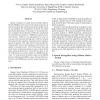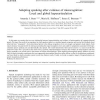2047 search results - page 27 / 410 » The limits of speech recognition |
ICPR
2006
IEEE
14 years 9 months ago
2006
IEEE
Speech recognition is usually based on Hidden Markov Models (HMMs), which represent the temporal dynamics of speech very efficiently, and Gaussian mixture models, which do non-opt...
NIPS
2001
13 years 10 months ago
2001
In the `missing data' approach to improving the robustness of automatic speech recognition to added noise, an initial process identifies spectraltemporal regions which are do...
TSD
2004
Springer
14 years 2 months ago
2004
Springer
Tracheoesophageal (TE) speech is a possibility to restore the ability to speak after laryngectomy, i.e. the removal of the larynx. TE speech often shows low audibility and intellig...
SPEECH
2008
13 years 8 months ago
2008
In this paper we examine the two-way relationship between hyperarticulation and evidence of misrecognition of computer-directed speech. We report the results of an experiment in w...
CISIS
2009
IEEE
14 years 3 months ago
2009
IEEE
—This paper presents an approach of location model deriving from language models existing in speech recognition research. The purpose is to applicate existing model in speech rec...


